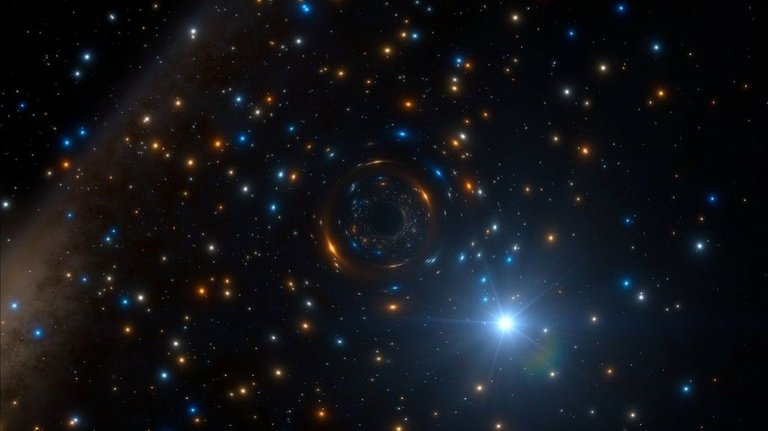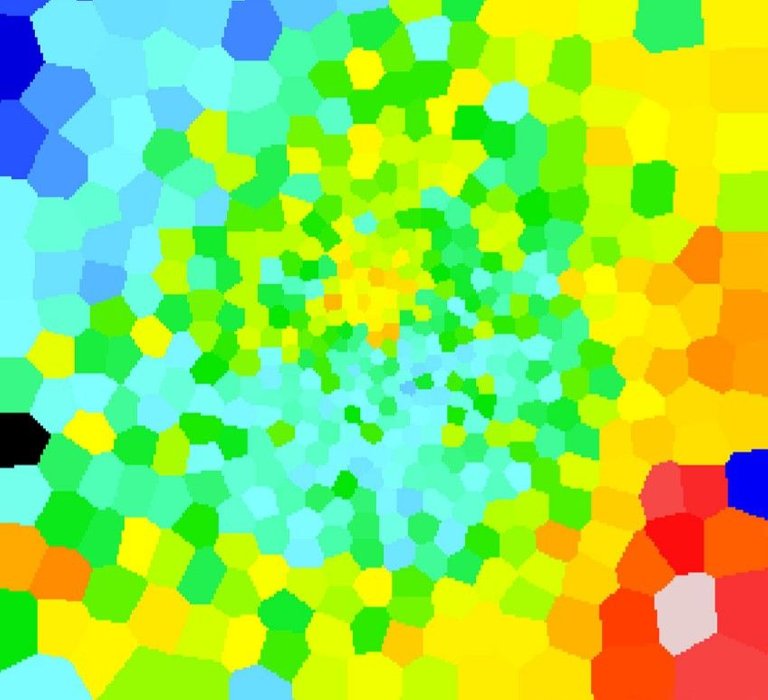In the vast universe in which we find ourselves, there are still many unknowns to be solved. As our technology increases and we are able to observe further and more accurately some questions get answers, but at the same time other questions arise.
1 - Artist's impression of the black hole binary system in NGC 3201. - Credits: ESO / L. Calçada / spaceengine.org
MUSE (Multi Unit Spectroscopic Explorer) is one of the tools that are installed in the VLT (Very Large Telescope) of the European Space Agency of the Southern Observatory (ESO), located in the Paranal desert in Chile. Is an integral field spectrograph (IFS), which allows the scientifics to observe a complete astronomical object at one time. Simply explained, this tool measures the intensity of light as a function of its color or wavelength to make a 3D map, where each pixel of the image has a complete spectrum of light.
2 - View of the giant elliptical galaxy Messier 87 using the MUSE. - Credits: ESO / VLT / MUSE
As we can see, this image looks like an abstract painting, something that comes from the mind of an artist. But no, that's how scientists see the galaxies that study using the MUSE. In this image, the colors are related to the movement of the stars of which that galaxy is composed. The red color represents stars that move away from us, the blue stars that approach and the green and yellow colors correspond to those that remain in the middle.
”MUSE has been built with the intention of studying the content and processes going on in the very early Universe, when the first stars and galaxies were forming,”
”Closer in time and space, MUSE will map the dark matter distribution in clusters of galaxies using the gravitational microlensing effect on background galaxies.”
Q1 - Fernando Selman, Instrument Scientist for MUSE. - ESO
ESO scientists studying the cluster called NGC 3201 have detected a star with odd behavior. A star that moves back and forth periodically at a very high speed. The pattern that follows the star is 167 days.
The strange behavior is not because of its orbital velocity, but because it seems to orbit an invisible celestial body.
“It was orbiting something that was completely invisible, which had a mass more than four times the Sun — this could only be a black hole! The first one found in a globular cluster by directly observing its gravitational pull.”
Q2 - Lead author Benjamin Giesers. - eso1802 — Science Release
This is how that lonely black hole was found, which seems inactive, since it isn’t swallowing all the matter that is around it. Therefore this black hole isn’t surrounded by a bright gas disk, as is usual. What has allowed him to go unnoticed until now. In this case it seems that an answer to the strange movement of that star has been found. However, more questions arise about the formation of those small, low-mass black holes.
“Until recently, it was assumed that almost all black holes would disappear from globular clusters after a short time and that systems like this should not even exist! But clearly this is not the case — our discovery is the first direct detection of the gravitational effects of a stellar-mass black hole in a globular cluster. This finding helps in understanding the formation of globular clusters and the evolution of black holes and binary systems — vital in the context of understanding gravitational wave sources.”
Q3 - Lead author Benjamin Giesers. - eso1802 — Science Release
Awesome, right?
Talking about inactive black holes, sounds almost contradictory. Something out of the ordinary. Taking into account the behavior of a standard black hole; that swallows everything that has the bad luck to get too close.
This is how the new questions are born.
How can an inactive black hole exist?
How many "invisible" black holes are there?
Will there be any black holes of these characteristics within our own galaxy?
A couple of days after my last post in which I talked about astronomical phenomena that shouldn't exist, ESO publishes this fascinating article about another astronomical weirdness. Which leads us to think, that our astronomical knowledge is still very limited and that the strange is becoming common in the field of Astronomy.
References
1, Q2, Q3 - eso1802 — Science Release
https://www.eso.org/public/unitedkingdom/news/eso1802/?lang
2 MUSE
http://www.eso.org/public/unitedkingdom/images/potw1441a/?lang
Q1
http://www.eso.org/public/unitedkingdom/teles-instr/paranal-observatory/vlt/vlt-instr/muse/

Gift-thanks to @markperandin
Let's take care of the pale blue dot
Enjoy your day. Enjoy your life.

Gift-thanks to @stellabelle


Excellent post! The first image looks amazing. I heard of super massive black holes, but never of an inactive black hole. This is first, thank you.
More oddities from space.
Im glad you liked it, thank you very much.
Hi, I found some acronyms/abbreviations in this post. This is how they expand:
This post has received a 12.76 % upvote from @aksdwi thanks to: @teks.
You got a 38.46% upvote from @votebuster courtesy of @teks!
@reveur ven
Peace, Abundance, and Liberty Network (PALnet) Discord Channel. It's a completely public and open space to all members of the Steemit community who voluntarily choose to be there.Congratulations! This post has been upvoted from the communal account, @minnowsupport, by teks from the Minnow Support Project. It's a witness project run by aggroed, ausbitbank, teamsteem, theprophet0, someguy123, neoxian, followbtcnews, and netuoso. The goal is to help Steemit grow by supporting Minnows. Please find us at the
If you would like to delegate to the Minnow Support Project you can do so by clicking on the following links: 50SP, 100SP, 250SP, 500SP, 1000SP, 5000SP.
Be sure to leave at least 50SP undelegated on your account.